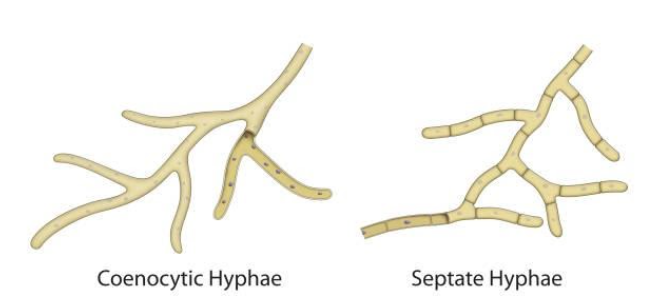
What is coenocytic mycelium?
Answer
573k+ views
Hint: Coenocytic refers to a structure of an organism or an organism itself, that has multiple nuclei in a continuous protoplasmic mass, enclosed by a cell membrane or cell wall. This condition is generally found in the case of algae or fungi.
Complete answer:
A majority of fungi are filamentous in their form. Meaning, they constitute long thread-like structures that are known as Hyphae. And a collection of hyphae is called Mycelium (Plural-mycelia). These mycelia can either be septate or coenocytic. Look at the diagram below:

Fig: Types of Hyphae
Concerning the diagram, the first set of hyphae has multiple nuclei (shown by the dark dots) in a continuous mass of protoplasm. This condition gives rise to the multinucleated or coenocytic condition, where several nuclei are enclosed by a cell wall in a continuous (undivided) mass of protoplasm.
In contrast, the second image shows a clear discontinuity in the protoplasm. And each divided section has one nucleus. This kind is known as Septate hyphae.
Now as we have stated earlier, that a collection or network of hyphae is known as Mycelium, so if the network is constituted by coenocytic hyphae, then such a Mycelium is known as Coenocytic Mycelium. Or simply to define it, a Coenocytic Mycelium is a network of multinucleated hyphae.
Here are some of the properties of a Coenocytic mycelium:
- Multinucleate
- Aseptate (lacks septa)
- Coordination
Additional information:
Coenocytic Mycelium is a characteristic feature of Phycomycetes.
Note: It has to be noted that the phenomenon of Coenocytic is not to be confused with Syncytium. The coenocytic condition arises when a cell fails to undertake cell division after the nuclear division. Syncytium occurs due to the fusion of multiple cells.
Complete answer:
A majority of fungi are filamentous in their form. Meaning, they constitute long thread-like structures that are known as Hyphae. And a collection of hyphae is called Mycelium (Plural-mycelia). These mycelia can either be septate or coenocytic. Look at the diagram below:

Fig: Types of Hyphae
Concerning the diagram, the first set of hyphae has multiple nuclei (shown by the dark dots) in a continuous mass of protoplasm. This condition gives rise to the multinucleated or coenocytic condition, where several nuclei are enclosed by a cell wall in a continuous (undivided) mass of protoplasm.
In contrast, the second image shows a clear discontinuity in the protoplasm. And each divided section has one nucleus. This kind is known as Septate hyphae.
Now as we have stated earlier, that a collection or network of hyphae is known as Mycelium, so if the network is constituted by coenocytic hyphae, then such a Mycelium is known as Coenocytic Mycelium. Or simply to define it, a Coenocytic Mycelium is a network of multinucleated hyphae.
Here are some of the properties of a Coenocytic mycelium:
- Multinucleate
- Aseptate (lacks septa)
- Coordination
Additional information:
Coenocytic Mycelium is a characteristic feature of Phycomycetes.
Note: It has to be noted that the phenomenon of Coenocytic is not to be confused with Syncytium. The coenocytic condition arises when a cell fails to undertake cell division after the nuclear division. Syncytium occurs due to the fusion of multiple cells.
Recently Updated Pages
Master Class 12 Business Studies: Engaging Questions & Answers for Success

Master Class 12 Economics: Engaging Questions & Answers for Success

Master Class 12 English: Engaging Questions & Answers for Success

Master Class 12 Maths: Engaging Questions & Answers for Success

Master Class 12 Social Science: Engaging Questions & Answers for Success

Master Class 12 Chemistry: Engaging Questions & Answers for Success

Trending doubts
What is meant by exothermic and endothermic reactions class 11 chemistry CBSE

Which animal has three hearts class 11 biology CBSE

10 examples of friction in our daily life

One Metric ton is equal to kg A 10000 B 1000 C 100 class 11 physics CBSE

1 Quintal is equal to a 110 kg b 10 kg c 100kg d 1000 class 11 physics CBSE

Difference Between Prokaryotic Cells and Eukaryotic Cells




